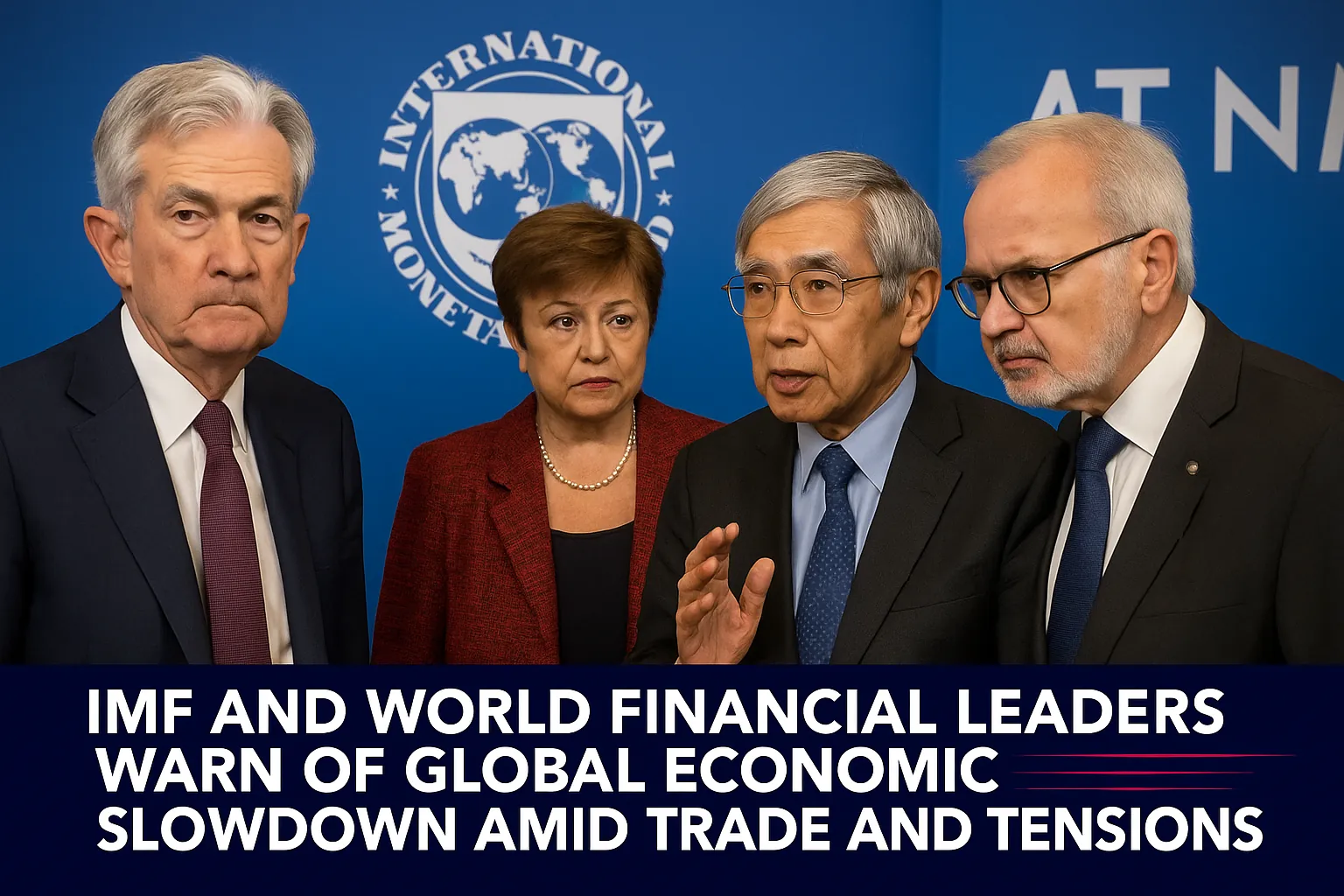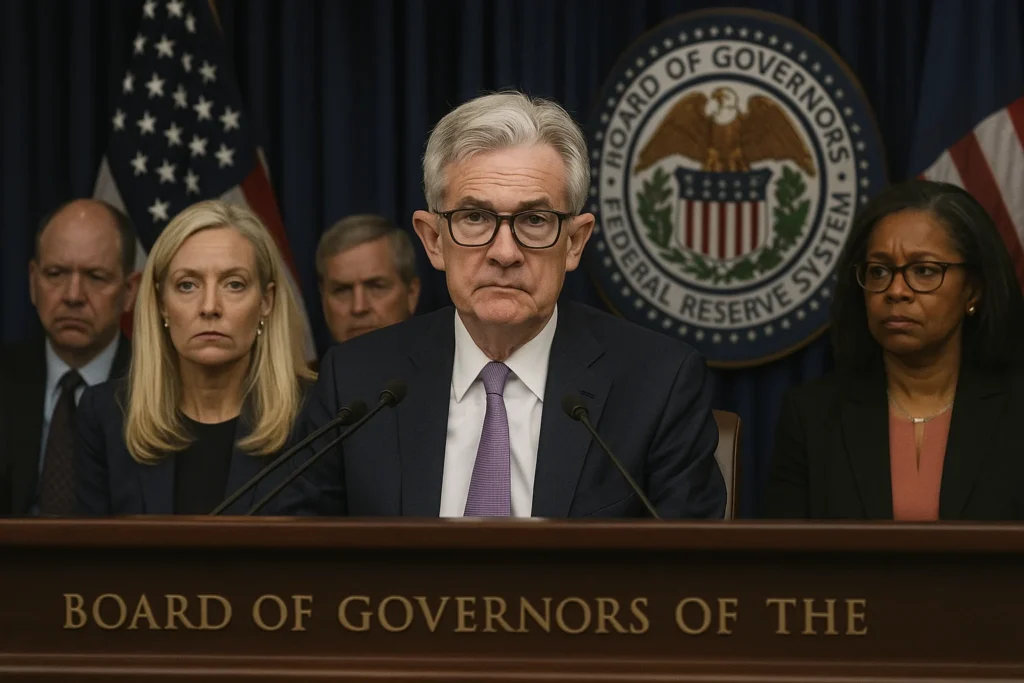At this year’s IMF and IIF meetings in Washington, the message from the world’s top economic leaders was unusually clear — and grim. The IMF global economic slowdown is no longer a distant risk; it’s a gathering storm. Central bankers, finance ministers, and CEOs from around the world warned that growth momentum is fading, trade tensions are deepening, and geopolitical fractures are turning into economic fault lines.
Behind the polished optimism of press conferences, the conversations in closed-door sessions were blunt. “We’re running out of tools,” admitted one senior European central banker, summarizing a mood of quiet alarm.
As global leaders gathered under the banner of “resilience and stability,” the numbers painted another picture: weakening industrial output, slowing trade flows, and investment uncertainty spreading across continents. What was once an “engine of recovery” after the pandemic is now sputtering — and the drivers of global capitalism are beginning to lose faith in their own machine.
Context: The IMF’s Grim Outlook
The International Monetary Fund’s latest World Economic Outlook set the tone. Global growth for 2026 was revised downward to just 2.7%, from earlier projections above 3%. Emerging markets, once the bright spot of global recovery, are faltering under the weight of high borrowing costs and weak demand from the U.S. and China.
According to IMF Managing Director Kristalina Georgieva, the global economy faces “a synchronized slowdown not seen in over a decade.” Her warning was echoed by finance ministers from Germany, India, and Japan — countries with sharply different political systems but the same anxiety: the global engine is losing power.
Even the U.S., which has so far outperformed Europe and China, is showing signs of fatigue. A recent Bloomberg survey found that more than 60% of economists expect U.S. growth to dip below 1.5% in 2026, largely due to tariffs, rising debt costs, and slowing consumer demand.
Oppositional Argument: A Crisis of Their Own Making
While IMF officials point to “external shocks” and “geopolitical headwinds,” the truth is more uncomfortable: global leaders are paying the price for a decade of complacency.
The same institutions that now warn of stagnation helped build it. Central banks kept rates artificially low for years, inflating asset bubbles and pushing governments to borrow recklessly. Trade organizations failed to prevent protectionism from creeping back into policy. And political elites used the language of globalization to mask economic inequality that hollowed out the middle class in every major economy.
The IMF’s plea for “coordinated fiscal responses” rings hollow. Where was this coordination when Trump reignited the tariff wars with China? Where was the warning when Europe’s energy policy became a hostage to Russian pipelines? The slowdown isn’t a surprise — it’s the consequence of choices made by the very people now calling for “stability.”
For many, the phrase global slowdown feels like diplomatic cover for what it really is: a self-inflicted wound of greed, short-termism, and geopolitical arrogance.
Analytical Breakdown: The Engines That Are Failing
To understand the depth of this slowdown, we need to look at the four engines of global growth — and how each is misfiring.
1. The U.S. — Tariffs and Consumer Fatigue
The American economy has been running hot for years, fueled by stimulus, tax cuts, and speculative investment. But the Trump administration’s renewed tariffs on China, Mexico, and the EU have pushed inflationary pressures back into the system. Import costs are rising again, and supply chains are struggling to adjust.
Household debt has surged to a record $19 trillion, while credit card delinquencies hit their highest levels since 2008. Consumers, once the backbone of global demand, are reaching their limit.
2. China — From Export Powerhouse to Uncertain Giant
Beijing’s growth model, long reliant on exports and construction, is under severe strain. The property crisis continues to drag down domestic confidence, while Western restrictions on high-tech exports — from semiconductors to AI chips — are cutting into industrial output.
China’s recent export controls on rare earth materials may look like a geopolitical counterpunch, but they also signal desperation. By restricting key inputs, Beijing risks isolating its own industries just when it needs them most.
3. Europe — The Sick Man of Globalization
Europe’s challenges are structural. Energy insecurity, political fragmentation, and sluggish productivity have created a toxic mix. The European Central Bank’s high interest rates have curbed inflation but also suffocated growth. Germany’s manufacturing base — once the pride of the EU — is now shrinking for the fifth consecutive quarter.
As one French economist put it bluntly during the IMF sessions: “Europe isn’t slowing down. It’s standing still.”
4. Emerging Markets — Rising Debt, Falling Hope
For developing economies, the situation is even worse. Over 40% of low-income countries are now in or near debt distress, according to IMF data. The strengthening dollar makes repayment even harder.
Nations from Kenya to Argentina are being forced to cut public spending and subsidies under IMF restructuring programs, triggering protests and political backlash. The so-called “resilience” agenda sounds very different in the streets of Nairobi than it does in the conference halls of Washington.
Human Perspective: What the Slowdown Means for Ordinary People
In the grand halls of the IMF, discussions revolve around “macro-prudential policy” and “liquidity buffers.” Outside those walls, people talk about rent, food, and jobs.
In Brazil, inflation has eroded wages faster than unions can negotiate. Meanwhile, IMF-backed austerity measures in Egypt have triggered bread shortages and electricity rationing. Across Europe, young workers face a job market that feels increasingly closed to them — no stability, no housing, no future.
Even in the United States, the supposed winner of this system, ordinary families feel cornered by rising costs and stagnant wages. When financial leaders speak of “temporary headwinds,” most hear empty words from the same class that never pays the price when crises hit.
Counterarguments: The Case for Optimism
Not everyone at the IMF meetings shared the doom. A handful of central bankers and private investors argued that the slowdown represents a necessary “reset.”
They claim that years of cheap money distorted global markets, and that slower growth will force economies to become more efficient and sustainable. Technological innovation, green investment, and regional supply diversification could, they argue, lay the foundation for a healthier system.
It’s an appealing narrative — but it assumes stability that no longer exists. Wars, climate disasters, and political populism are all pushing in the opposite direction. Efficiency doesn’t thrive in chaos.
Conclusion: The End of Global Economic Illusion
The IMF’s warnings might sound technical, but the implications are profoundly political. What we’re witnessing isn’t just a slowdown — it’s a reckoning.
The world’s financial order was built on the assumption that global integration would naturally lead to prosperity. That assumption is collapsing. Nationalism, sanctions, tariffs, and resource hoarding have replaced cooperation. The result isn’t resilience — it’s fragility disguised as strategy.
When global elites in Washington speak of “managing the slowdown,” they’re really talking about managing perception. But numbers don’t lie. Growth is stalling, inequality is deepening, and the promise of a self-correcting global market has turned into a myth.
The truth is simple but inconvenient: the system worked until it stopped serving those who built it. Now, it serves no one.
For the IMF and its partners, the real question isn’t how to restore growth — it’s how to restore credibility.
External Links
- Bloomberg – Why Global Economic Leaders Predicted a Slowdown at IMF Meetings
- IMF World Economic Outlook Report
23 views






